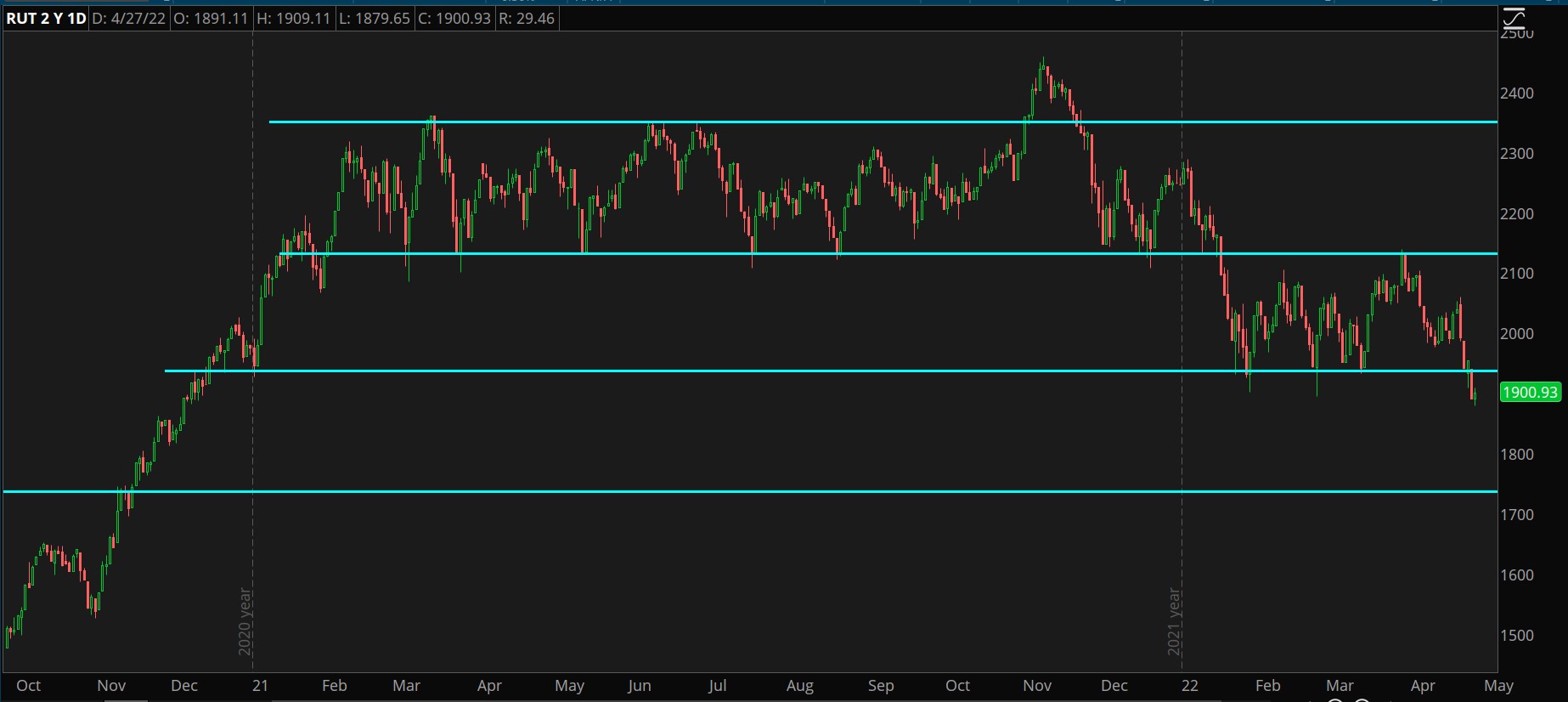
This post contains sponsored advertising content. This content is for informational purposes only and not intended to be investing advice.
(Thursday Market Open) The bulls approached another run as the major indexes try to stay above key support levels. Yesterday’s morning surge failed soon after the open, but today’s slew of positive earnings announcements may not be enough to stave off a negative gross domestic product (GDP) report.
Potential Market Movers
The first read for gross domestic product (GDP) came in much lower than expected at -1.4%. Analysts had expected 1.1% and the Atlanta Fed GDP tracker was looking at 0.4%. Consumer spending was a drag at 2.7% instead of the forecasted 3.5%. Lower consumption hurts one of the bulls’ key narratives—that the consumer is still strong. Also, the economy was hurt by fewer exports. Exports were slowed by a weaker global economy and an increasingly strong U.S. dollar.
The GDP price index measured inflation growth at 8%, above earlier forecasts of 7.3%. The big question on investors’ minds is whether this means the start of a recession. Low inventories should stave off a recession as manufacturers and producers will look to rebuild those inventories.
Equity index futures did trade slightly lower on the GDP news, but overall, they were still higher before the opening bell. The Cboe Market Volatility Index (VIX) is still over 30, which signals caution.
One reason for higher equity futures is a slew of positive earnings reports. After yesterday’s market close, Meta Platforms (NASDAQ: FB) reported better-than-expected earnings despite missing on revenue estimates. However, the company was able to add daily active users, which was a concern after the previous earnings report. The company provided forward guidance in the middle of the recently lowered analysts’ expectations and cited “currency headwinds” as an issue going forward in addition to Meta platforms are still turned off in Russia. Meta continues to struggle with Apple’s (NASDAQ: AAPL) new privacy settings as well as competition from TikTok. If this sounds familiar, Alphabet (NASDAQ: GOOG) reported almost identical issues on Tuesday.
The Dow Jones Industrial Average ($DJI) should get a boost from its components Merck (NYSE:MRK) and McDonald’s (NYSE:MCD) as both beat on earnings and revenue estimates. Both companies also traded about 2% higher in premarket action. MRK got a boost from sales of its COVID-19 antiviral treatment and MCD saw gains in international sales.
The Nasdaq Composite ($COMP) may get help from Qualcomm (NASDAQ:QCOM), which was up 6.44% in premarket trading on better-than-expected earnings due to big increases in handset sales. PayPal (NASDAQ:PYPL) was also up 2.86% before the opening bell after beating on top- and bottom-line numbers and despite reducing its forward earnings guidance.
After the today’s close, Big Tech earnings week continues with Apple (NASDAQ: AAPL), Amazon (NASDAQ: AMZN), and Intel (NASDAQ:INTC). As the major indexes hover around important technical levels, these mega-cap companies could make a big market difference. Apple and Intel are in all the major indexes and Amazon is in the S&P 500 (SPX) and the Nasdaq Composite ($COMP). These heavyweights carry a lot of clout in these cap-weighted averages.
Reviewing the Market Minutes
Positive earnings news from Microsoft (NASDAQ: MSFT), Visa (NYSE:V), and T-Mobile (NASDAQ:TMUS) appeared to outweigh negative reports from Alphabet (NASDAQ: GOOG), and Boeing (NYSE:BA) as the S&P 500 (SPX) ended the day up 0.21%. The Dow Jones Industrial Average ($DJI) also closed 0.19% higher, but the Nasdaq Composite ($COMP) ticked slightly lower on the day.
However, appearances may be deceiving as stocks tried to bounce back from yesterday’s sell-off with the SPX and the $COMP rallying 1.6% each on the open. However, the bears almost immediately started selling after the open drove stocks lower. While the major indexes did close mostly positive, the NYSE and Nasdaq saw more decliners than advancers.
On Wednesday, there were hints that Shanghai may be closer to coming out of lockdown, but thousands more cases of COVID-19 were reported. This revelation is one reason stocks failed to hold the surge. If lockdowns expand, U.S. companies will continue to have trouble accessing supplies for goods and services, which could raise costs and cut profits.
Closer to home, news on the housing market was split. Pending home sales in March saw a smaller-than-expected drop, but home sales keep falling. Additionally, mortgage applications were down 8.3% from last week adding to the previous week’s drop of 5%. The Mortgage Bankers Association’s 30-year mortgage rate rose to 5.37% from 5.20% last week. Homebuilders appeared to be mostly unaffected by the news. The S&P Homebuilders Select Industry Index closed just 0.15% lower on the day.
Oil prices also appeared to be unmoved by weekly crude oil inventories, which were smaller than expected. WTI crude futures settled 0.3% higher on the day at $101.75 per barrel. Much of the movement in oil took place before the stock market opened.
The 10-year Treasury yield (TNX) bounced back, closing up 46 basis points to 1.66%. The 2s10s yield spread appears to be widening again—a good sign for the yield curve as it starts to steepen once more.

CHART OF THE DAY: THE THIRD CIRCLE. The Russell 2000 (RUT) broke support on Wednesday. Many technical analysts would likely target the 1,740 level for support. Data Sources: ICE, S&P Dow Jones Indices. Chart source: The thinkorswim® platform. For illustrative purposes only. Past performance does not guarantee future results.
Three Things to Watch
Gluttony Level: The Russell 2000 (RUT) broke support on Wednesday, which Dante might describe as just deserts for the gluttonous. Small-caps need investors to stop loading up on defensive and safe-haven assets. Aside from the extra risk small companies bring, three of RUT’s highest weightings are in financials, consumer discretionary, and technology. It doesn’t have mega-cap bellwethers like Microsoft (NASDAQ: MSFT) or Apple (NASDAQ: AAPL) to keep it anchored.
With the Cboe Market Volatility Index (VIX) still above 30, there’s enough fear in the market that the RUT could move down to the avarice level. The RUT needs a little greed to motivate buyers to go back into “risk on” mode and start buying these stocks.
If the RUT was eventually to break the 1,740 level, it would be breaking highs from 2018 and 2019. A break of those levels would likely be seen as a bad signs for all stocks, but there’s some space before we hit purgatory—or below.
Weight Problems: While value stocks have been the best place to be over the last six to eight months, the S&P 500 Pure Value Index recently failed to sustain a breakout. This was likely due more to the overall market weakness than a rejection of the strategy or asset class. The index is down about 6.2% from its April high, which is in line with the S&P 500 (SPX) over the same time period. It’s better than the S&P Pure Growth Index, now down about 8.8%.
However, the value index has some weighting issues of its own. Financials make up more than 30% of the index, and they haven’t been stellar. Health care is the second highest at 11.7%, followed by consumer staples at 10.6%. The higher weighting in these two defensive sectors has been positive. Energy follows at 9% and materials at 8%.
It’s important not to compare the Russell 2000 and the value index too closely. They’re quite different. The RUT is all small-cap index where the value is about 42% large cap and only 1% small cap. Large-cap stocks are generally less volatile than small-cap stocks. Mid-cap stocks make up the remainder. Additionally, RUT doesn’t account for valuations, which means it’s likely to have much more volatile stocks with high multiples in its ranks.
Floating FAANGs: It’s likely that some of you have experience with horses and know you must grind or “float” their teeth to keep them from hurting themselves. It could be time to float the FAANGs. Recently, there’s been a bit of push to change the name FAANG to MANGA because of company name changes. FAANG stocks include Facebook, which is now called Meta (NASDAQ: FB), Apple (NASDAQ:AAPL), Amazon (NASDAQ: AMZN), Netflix (NASDAQ: NFLX), and Google, which is now called Alphabet (NASDAQ: GOOG). MANGA makes some adjustment for Meta, Amazon, Netflix, Google, and Apple, although it still has Google instead of Alphabet.
There’s one more issue. FAANG stocks were popular over the last 10+ years because of their price growth, but now some of them are heading the wrong direction. Before the recent sell-off, Netflix was the all-star of the group over the decade, returning 6,500%. Today, it’s still the top performer, but its 10-year return fell to 1,700%. Additionally, its market cap is now around 84th in the S&P 500 depending on the day.
And finally, the FAANG acronym left out one of the biggest technology stocks—Microsoft (NASDAQ:MSFT). Some are now trying to push for MAGMA, better known as Meta, Apple, Google (Grr, come on!), Microsoft, and Amazon (switching Netflix for Microsoft). And others want to add Tesla (NASDAQ: TSLA) because its market cap is the fifth highest in the S&P 500 behind Apple, Microsoft, Alphabet, and Amazon. Before this latest earnings announcement, Meta had lost enough market cap that it fell to 9th in the S&P 500.
The name game continues.
Notable Calendar Items
April 29: Earnings from Exxon (NYSE:XOM), Chevron (NYSE:CVX), and AbbVie (NYSE:ABBV)
May 2: ISM Manufacturing PMI and earnings from Berkshire Hathaway (NYSE: BRK/A), Devon Energy (NYSE:DVN), and Expedia (NASDAQ:EXPE)
May 3: JOLTs Job Openings and earnings from Pfizer (NYSE:PFE), Advanced Micro Devices (NASDAQ:AMD), and Airbnb (NASDAQ:ABNB)
May 4: FOMC Interest Rate Decision and earnings from Novo Nordisk (NYSE:NVO), Moderna (NASDAQ:MRNA), MetLife (NYSE:MET), and Marriott (NASDAQ:MAR)
May 5: Earnings from Shell (LON: SHEL), ConocoPhillips (NYSE:COP), and Anheuser Busch (NYSE:BUD)
TD Ameritrade® commentary for educational purposes only. Member SIPC.
Image sourced from Unsplash
This post contains sponsored advertising content. This content is for informational purposes only and not intended to be investing advice.







